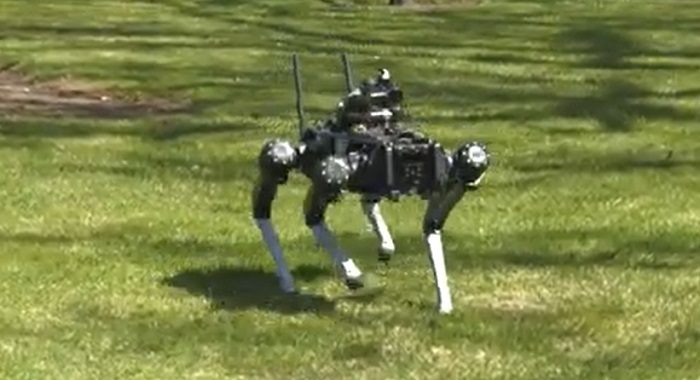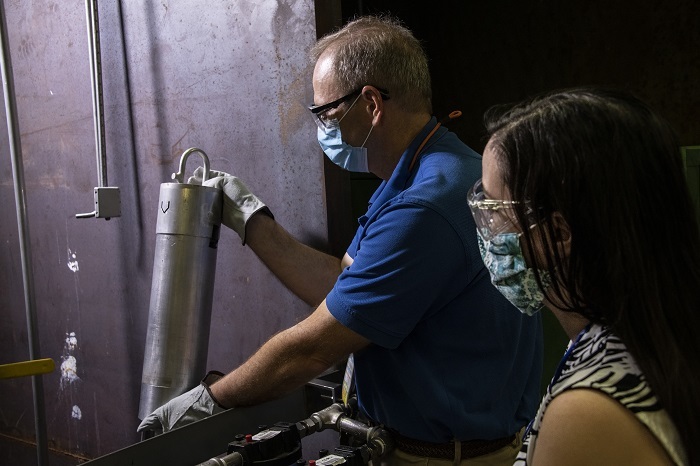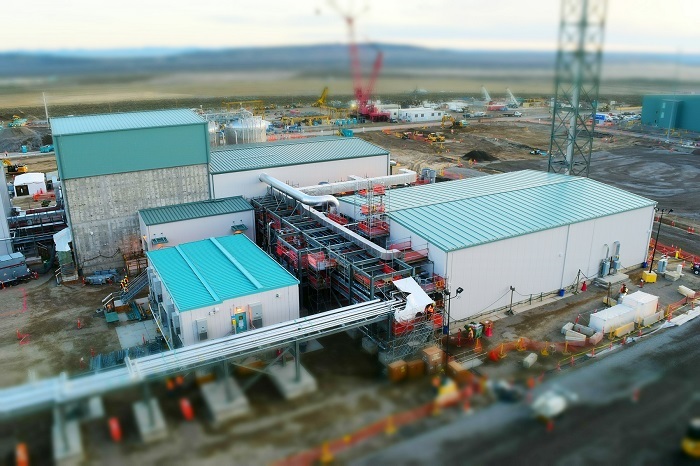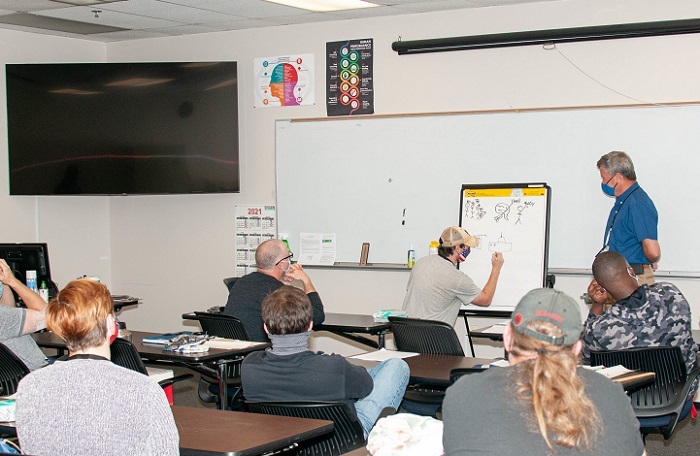|
Taking the “dog” for a walk: Central Plateau Cleanup Company Radiation Area Remedial Action Manager Roy Plunkett tries his hand at the controls of a four-legged, remotely operated robot that aims to improve worker safety and increase productivity at Hanford.
RICHLAND, Wash. – EM Richland Operations Office (RL) contractor Central Plateau Cleanup Company (CPCCo) is evaluating new robotic technology that could further improve worker safety at the Hanford Site.
CPCCo leadership and field work supervisors recently conducted a demonstration of a remotely controlled, four-legged unit — a robotic “dog” — that could help workers access difficult-to-reach areas or keep them away from potentially hazardous materials.
“Demonstrations like this are a great opportunity for us to get up close and personal with emerging technologies, so we can start to think about how they might be used in the workplace to improve safety and drive productivity,” said Andy Wiborg, RL operations activities team lead, projects and facilities division.
 *Robotic "dog" video alert* Click here to watch a brief video of a demonstration of a remotely controlled, four-legged unit that could help workers access difficult-to-reach areas or keep them away from potentially hazardous materials.
Remote-controlled robotics are often used at Hanford to reduce worker exposure to some of the higher-risk elements associated with site cleanup. While this isn’t the first time this type of technology has been evaluated, this particular unit has some unique abilities that can come in handy navigating Hanford’s challenging work environment.
“What’s great about this unit is the quadra-ped, or four feet, can navigate some of the terrain that machines with wheels or tracks can’t,” said Tom Bratvold, CPCCo inner area end states integration manager. “It can get into the desert environment and some of the other terrains we see out on the Hanford Site where we have encountered some issues with other robotic units.”
The applications for this technology are wide ranging, but one of the biggest benefits is it allows planners to design work packages that offer more safety to workers.
“By using these machines, we can keep our workers out of harm’s way while continuing on our path to reduce risk on Hanford’s Central Plateau,” Bratvold said.
-Contributor: Rob Roxburgh
Members of eight local advisory boards across the DOE complex focused on opportunities and challenges at cleanup sites and interacted with EM leaders during a recent two-day virtual meeting.
EM Principal Deputy Assistant Secretary Todd Shrader provided an update to the eight boards, which make up the Environmental Management Site-Specific Advisory Board (EM SSAB). Shrader recognized the efforts of the boards, and noted that EM values their recommendations and advice.
“It’s an important service to our sites and to headquarters and EM as a whole to get the advice of the leaders of the communities around our sites,” Shrader said. “We know you do a lot of work behind the scenes and we certainly very much appreciate that.”
 |
|
Representatives of eight local advisory boards that make up the Environmental Management Site-Specific Advisory Board recently met for a two-day virtual meeting to discuss opportunities and challenges at EM’s cleanup sites. |
Associate Principal Deputy Assistant Secretary for Regulatory and Policy Affairs Mark Gilbertson, EM Office of Budget and Planning Director Steve Trischman, and EM Advisory Board Vice-Chair Jack Craig also provided updates. Officials with the Consortium for Risk Evaluation with Stakeholder Participation discussed best practices in communicating environmental risks and answered questions from board members.
Members of the local advisory boards also sought a path forward on tasks they had been charged with. That work included determining best practices and opportunities for improvement for EM’s outreach program, and identifying expectations for EM interactions with local communities related to EM’s 10-year strategic vision. Committees were formed to develop responses to these charges, which will be discussed during the EM SSAB National Chairs Meeting in October.
“I am very excited to see the recommendations and best practices that the committees will develop based on the two charges given to the EM SSAB,” EM SSAB Designated Federal Officer Kelly Snyder said. “Ensuring community members have a path for obtaining meaningful communication via our advisory boards is a key component of EM’s commitment to transparency. Who better to tell us what the communities want in terms of outreach and communication than from the community members themselves.”
Last month, EM released its Strategic Vision 2021-2031, a blueprint to the program’s anticipated accomplishments over the next decade that will protect the public and environment. The Strategic Vision outlines goals focused on safety, environmental cleanup priorities, innovation, and improved performance.
The SSAB was created to involve stakeholders more directly in EM’s cleanup decisions, providing advice and recommendations on cleanup and environmental management activities.
The local boards are the Hanford Advisory Board, Idaho Cleanup Project Citizens Advisory Board (CAB), Northern New Mexico CAB, Nevada SSAB, Oak Ridge SSAB, Savannah River Site CAB, Portsmouth SSAB, and Paducah CAB.
The boards are composed of representative members of local citizens, Native American tribes, state and local governments, and community and public interest groups.
Click here for more information on the EM SSAB.
-Contributors: Kelly Snyder, Barb Ulmer
 Savannah River Nuclear Solutions and Savannah River National Laboratory (SRNL) developed a mock-up to test underwater cameras and accompanying long-handled tools to perform examinations of spent nuclear fuel bundles in a basin at the Savannah River Site. Here SRNL employee Kevin Counts holds a small section of a test bundle against an underwater camera as SRNL employee Lisa Ward looks on.
AIKEN, S.C. – EM and the management and operations contractor at the Savannah River Site (SRS) recently used underwater cameras for the first time to complete examinations of non-aluminum-clad spent nuclear fuel bundles stored in a basin, helping ensure the integrity of the storage systems.
Most spent nuclear fuel stored in the site’s L Basin is covered, or clad, in aluminum and then placed in aluminum bundles. However, a small portion of the fuel in L Basin is housed in aluminum bundles but clad in stainless steel or zirconium alloy, a type of metal know for its hardness and corrosion resistance.
“We needed a way to inspect the aluminum bundles that house non-aluminum-clad spent nuclear fuel to make sure galvanic corrosion wasn’t occurring,” Savannah River Nuclear Solutions (SRNS) Augmented Monitoring and Condition Assessment Program (AMCAP) Manager Michelle Hromyak said. “Galvanic corrosion happens when two metals that are dissimilar in nature — in this case the aluminum bundles and the zircalloy or stainless steel-clad spent nuclear fuel — are closely coupled underwater and one metal corrodes the other.”
 Employees used cameras attached to long-handled tools to inspect the sides and the bottom of spent nuclear fuel bundles during recent examinations in L Basin at the Savannah River Site.
AMCAP provides examination capabilities of the spent nuclear fuel to help extend the safe storage of the material until its final disposition.
After specifically selecting the cameras to withstand the radiochemistry of the water while being submerged approximately 30 feet into the basin, SRNS worked with Savannah River National Laboratory (SRNL) to design the long-handed tools to hold the cameras during the inspections.
In advance of the examinations, SRNL and SRNS developed a mock-up to test the cameras and the accompanying long-handled tools.
“Over the next few years, we plan to continue visual examinations to ensure fuel integrity,” Hromyak said. “With SRNL’s help, we are also developing ultrasonic testing capability to validate the integrity of the fuel inside the bundles and determine if any worsening storage conditions are occurring that we cannot see with just visual examinations.”
Spent nuclear fuel is nuclear fuel that has been irradiated in a nuclear reactor. The spent nuclear fuel from the site’s former production reactors, and from foreign and domestic research reactor programs, is safely stored in an underwater storage facility in L Area, called a disassembly basin.
L Basin has concrete walls up to 7 feet thick and holds approximately 3.4 million gallons of water, with pool depths up to 50 feet. The basin water provides shielding to protect workers from radiation. Since 1964, SRS has received more than 2,400 casks containing over 47,500 spent nuclear fuel assemblies.
-Contributor: Lindsey MonBarren
 Bruno Zovi, Fluor Idaho waste disposal and waste generator services manager, inspects a waste shipment before it is loaded on a tractor trailer for disposal at an off-site facility.
IDAHO FALLS, Idaho – An Idaho National Laboratory (INL) Site program has adapted to the challenges of the COVID-19 pandemic and continues to ship waste out of the state in support of the 1995 Idaho Settlement Agreement.
In the last year, EM INL Site cleanup contractor Fluor Idaho’s waste generator services (WGS) program completed 82 off-site shipments of newly generated and stored low-level and mixed low-level radioactive waste, which includes contaminated debris, soils, sludges, salts, and liquids. In all, workers shipped about 530 cubic meters of waste offsite for permanent disposal — an amount equivalent to about 2,545 55-gallon drums.
“This achievement was accomplished by utilizing off-site disposal facilities, on-site treatment, new waste characterization technology, and waste consolidation,” said Bruno Zovi, Fluor Idaho waste disposal and waste generator services manager. “In short, it was great teamwork by several organizations working through numerous issues.”
Zovi said the WGS program instituted several safety protocols during the pandemic, including use of masks, social distancing, reduced on-site staff, and quarantines when program personnel had contact with a person that tested positive for COVID-19.
“After the COVID-19 pandemic hit, we had to rethink how we could conduct business despite the challenges that we as an organization and the country as a whole were facing,” Zovi said. “We hardly missed a beat.”
Zovi said the WGS employees took the challenges in stride and adapted.
“We’ve proven that despite these challenges, we can still safely ship waste offsite and fulfill the promises that were made to the citizens of Idaho,” he said.
-Contributor: Erik Simpson
 All systems for Hanford’s Effluent Management Facility have been tested and handed over to Waste Treatment and Immobilization Plant management for commissioning.
RICHLAND, Wash. - The EM Hanford Waste Treatment and Immobilization Plant team recently finished all startup testing and system handovers for the Effluent Management Facility (EMF), marking its full transition into the commissioning phase.
“This caps off a significant cohesive effort across the treatment plant project,” said Mat Irwin, EM Office of River Protection deputy assistant manager for the plant. “Handing over all systems and areas of the EMF to plant management is a huge step toward treating Hanford’s tank waste.”
Progress since construction began on EMF can be seen in a new video. The EMF plays a key role in Hanford’s Direct-Feed Low-Activity Waste (DFLAW) approach to treating tank waste. DFLAW is a system of interdependent projects and infrastructure improvements, managed and highly integrated as a program, that must operate together to vitrify the tank waste, which means immobilizing it in glass. During DFLAW operations, secondary liquid called effluent is generated. This effluent goes to the EMF, where excess water is evaporated from it and transferred to a nearby retention facility.
 Antonio Corona, commissioning technician for Waste Treatment Completion Company, a subcontractor to project lead Bechtel National, Inc., conducts inspections inside the Effluent Management Facility powerhouse building as part of the completion of startup testing.
The EMF includes 77 integrated systems across four buildings. After startup testing for each EMF system was finished, the startup team documented the results, and each system was handed over to the plant management team to initiate commissioning. The commissioning phase ensures the utilities and process systems are integrated and ready to support future plant operations.
“Everyone from our skilled craft workers, test engineers, control room staff, handover coordinators, and all of our EMF support organizations stepped up to make this final stretch of handovers successful,” said Rick Holmes, general manager for Waste Treatment Completion Company, a subcontractor to project lead Bechtel National, Inc. “Now, we will continue focusing on completing handovers for the remaining treatment plant systems.”
The only remaining DFLAW startup activities are within the Low-Activity Waste (LAW) Facility, where the vitrification process will occur. To date, about 50 percent of the facility’s 94 systems have been handed over to plant management, with completion of all systems anticipated later this summer.
The treatment plant team expects to begin heating up the first melter inside the LAW Facility by the end of the year. Information on the commissioning process, including a loss-of-power test and melter heatup, is available here.
The WTP facilities can be viewed using the self-guided Hanford Virtual Tour.
-Contributor: George Rangel
 Production Operator Apprentice Brandon Richardson participates in a dynamic learning activity at the human performance improvement lab at the Savannah River Site. Conduct of Operations Program Manager Daryl Smoldt is to the right of Richardson.
AIKEN, S.C. – The Savannah River Site recently took steps to strengthen the use of human performance improvement (HPI) tools to help personnel reduce the chance and severity of errors while performing work activities.
Human performance is generally recognized as a series of behaviors carried out to accomplish specific tasks. HPI principles provide a systematic approach to improving individual and organizational performance.
“SRS began using HPI tools approximately 15 years ago, and while we have continued their use, the emphasis on their importance in everyday activities had become stale over time,” said Daryl Smoldt, conduct of operations program manager for Savannah River Nuclear Solutions, the management and operations contractor of SRS. “HPI tools provide workers with methods to help anticipate, prevent, or catch errors, and we want to make sure they are top of mind and accessible for all employees. To do this, we took a fresh look at how we taught and reinforced these tools and looked at ways to make them better.”
Recent efforts include developing short HPI videos accessible to all employees; integrating HPI more closely with conduct of operations principles; developing an HPI sustainability plan; and establishing an HPI lab, which is home to electronic devices that react in real time to participants as they follow directions in a procedure.
“The HPI lab is accessible to all site employees and uses dynamic learning activities to help participants understand HPI tools by using them in a fun and hands-on way,” Smoldt said.
In one activity at the lab, an employee describes a specific structure built from Legos, while another employee tries to assemble that structure using Legos. The two participants do not see each other during the exercise.
"This activity shows participants the hazards of imprecise communication habits, interpretation requirements, and assumptions, and emphasizes the error-reduction tools of a questioning attitude, three-way communications, and pre-job briefing, to name a few,” Smoldt said.
HPI tools include self-checking, peer-checking, timeouts, use of the phonetic alphabet, procedure use and adherence, flagging, task preview and job site review, pre-job briefings, a questioning attitude, and use of three-way communications. Although the tools are commonly used by employees in operations, personnel in administrative and support roles employ them as well.
-Contributor: Lindsey MonBarren
|